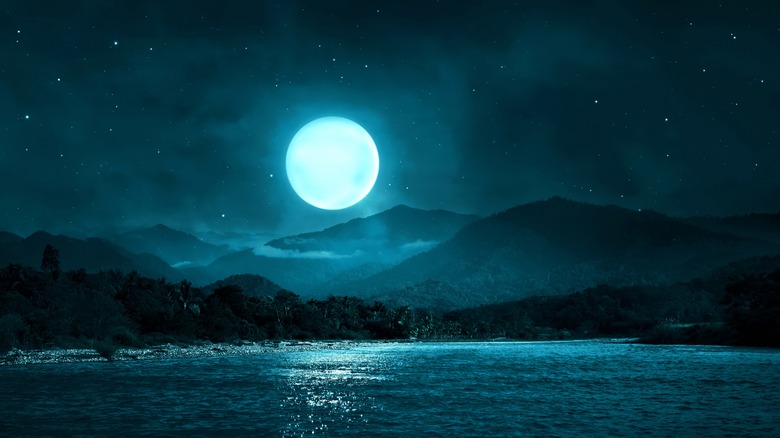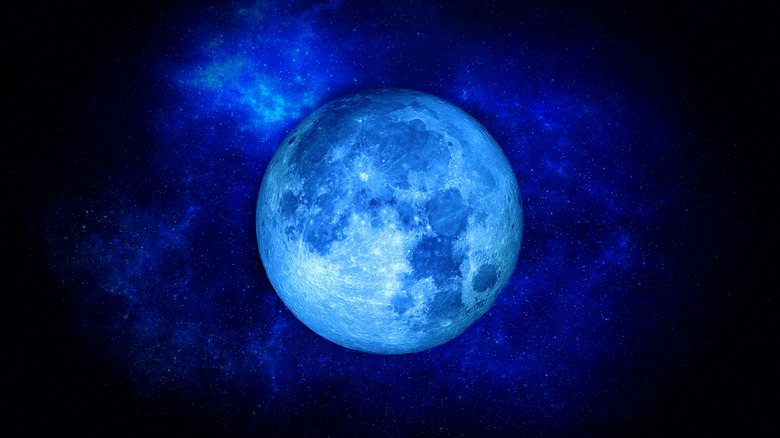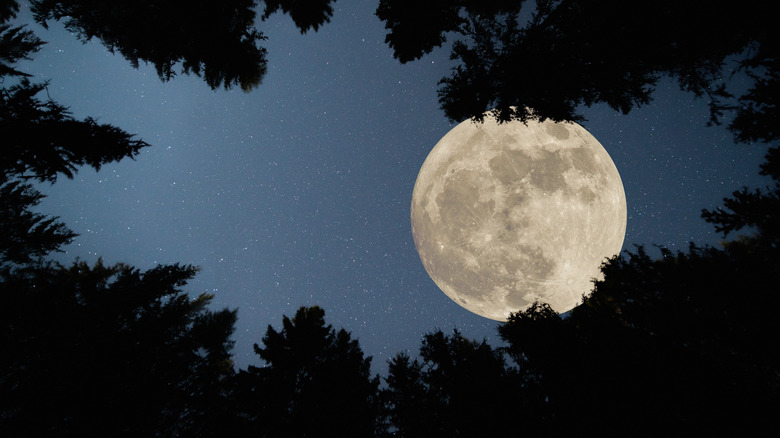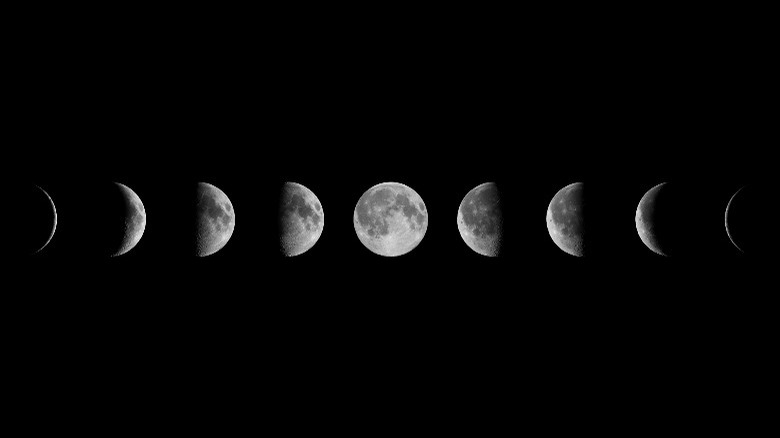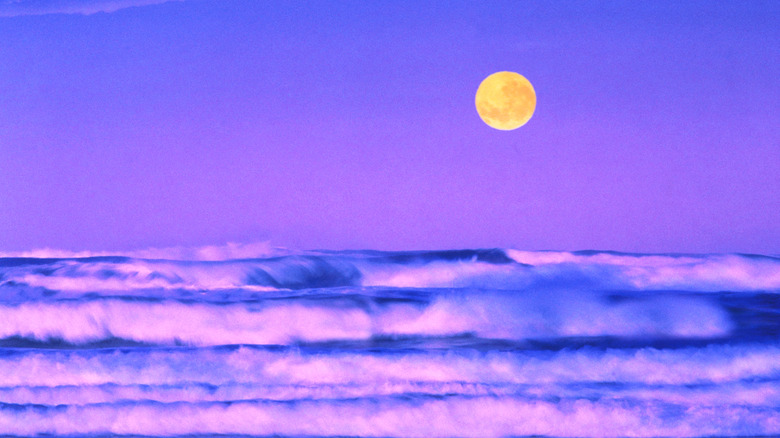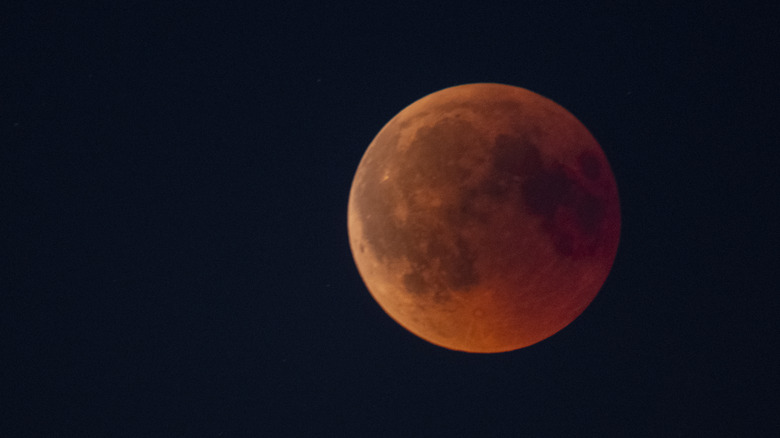The Phenomenon Of Super Blue Moons Explained
When it comes to objects in the night sky, no object is quite as important as the moon. The observations of its phases not only gave rise to the month as a unit of time, but the word "moon" is the root of the word for "month." Given the importance of the cycles of the moon, both historically and today, it's no wonder that its movements are tracked so avidly across cultures. This importance is reflected in the multitude of names created to describe the moon, not just in its monthly procession around the Earth, but also in its relation to the Earth's annual journey around the sun.
From an astronomical point of view, the only names that have any scientific foundation are the full moon and the new moon which occur when the sun and moon are in syzygy (alignment) in relation to the Earth. But that hasn't stopped humanity from giving unique names, such as "Buck Moon," to each full moon of the year, and that's why, once a decade or so, the world is treated to a super blue moon. But what does that even mean?
What is a blue moon?
One of the most commonly remarked upon of full moons is the so-called blue moon. In its original sense, a blue moon was a metaphor for something that was impossible or absurd. Following the 1883 eruption of the Krakatoa volcano, it was said the moon appeared blue in some parts of the world, which led to the term "blue moon" being referred to as a rare event instead of an impossibility.
The origin of our current definition of a blue moon is a bit convoluted, so buckle up. Most years have 12 full moons, but because the moon's phase cycle (synodic month) is ~29.5 days, some years will have 13 full moons. Further, because the normal 12 full moons are named based on which month they occur in, the extra full moon is called a blue moon. But which of these rare full moons gets to be blue?
Originally, that designation was given to the third full moon in a season that had four instead of the typical three. This odd system was used to ensure that the named moons occurred during their traditional timeframes. Then, in the mid 1940s, the popular understanding of a blue moon simplified to being just the second full moon in a calendar month.
What is a supermoon?
The cycle of the moon's phases is relatively constant, but, due to its elliptical orbit, its distance from the Earth is not. Over the course of a month, the moon moves between its closest distance to Earth (perigee) and its farthest distance to Earth (apogee). This means that the moon appears almost 15% larger and up to 30% brighter during perigee than it does at apogee.
The period of time between two consecutive perigees is called the anomalistic month. Because the anomalistic month (~27.5 days) is not the same as the synodic month, the apparent size of the full moon from Earth can vary from month to month. When a full moon and a perigee coincide, you get a supermoon. When a full moon and an apogee coincide, you get a micromoon.
Of course it's not quite that simple because the concept of a supermoon was invented by Richard Nolle, an astrologist. In other words, supermoons aren't precisely an astronomical phenomenon. Although NASA doesn't have an official definition for a supermoon, when it talks about them, it calculates a supermoon to be a full moon that is within 90% of the distance of perigee. Because of this imprecision, there are usually four supermoons in a row, and there can be up to five. It's even possible to have two in the same month.
How often do super blue moons occur?
The phrase "once in a blue moon" has become shorthand for anything that doesn't occur very often, but given that it is known how often blue moons occur, their rate of occurrence can be predicted. Leaving aside the complicated math, we know that blue moons occur seven times in 19 years. In contrast, supermoons are much more common. Due to the broad scope of their definition, it's possible to have as many as five consecutive supermoons in a single year, although four is more common.
By combining these two probabilities, it's possible to calculate the rough odds of a blue moon coinciding with a supermoon to create a super blue moon. If you combine the 3% chance of a blue moon occurring in a given month with the 25% chance of a supermoon, you get a ~1% chance per month of a super blue moon. In real terms, that's around once every 10 years, but it can be up to 20.
What are the effects of a super blue moon?
The confluence of a blue moon and a supermoon does not affect the Earth or the moon (or you) in any way. Having said that, the proximity of the supermoon can have a direct effect on the Earth, specifically with the tides. Tides are caused by the gravitational interplay of the sun and moon on Earth's oceans. The tides are highest during a new and a full moon, and the closer proximity of a supermoon can amplify those effects.
Some have speculated that a correlation exists between the moon's gravitational pull on the surface of the Earth (Earth tide) and the frequency and intensity of seismic activity. In fact, some of the largest earthquakes of the 21st century have happened right around the time of a full or new moon. Despite this, when you account for the totality of seismic events around the world, it's hard to find a statistical correlation between the Earth's tide and earthquakes. What scientists have found is an increased likelihood of smaller earthquakes deep in the crust developing into larger earthquakes when there is more tidal stress on the Earth, such as when there is a supermoon.
Other moons to watch out for
Given the cultural importance of the moon, it shouldn't be a surprise that there are more than a few special moons to look out for. The most famous of these special moons is the so-called blood moon, when the moon takes on a red color. The blood moon is actually a total lunar eclipse and its crimson color comes from sunlight being filtered through the Earth's atmosphere.
Keeping with the chromatic theme, a black moon is the second new moon of a given month. Black moons are a recent conception, and unlike a blue moon, are completely invisible to the naked eye (unless it happens to pass in front of the sun).
Naming moon phases is such a common occurrence that many cultures have names for each full moon of the year. Music lovers will likely have heard of a harvest moon thanks to Neil Young's famous 1992 song of the same name. A harvest moon is the full moon closest to the autumn equinox. So, if there are two full moons in September, and the second one also happens to coincide with perigee, and it's a total lunar eclipse, it would be a super blue harvest blood moon — and those are truly rare, with the next one occurring on September 30, 3280.
